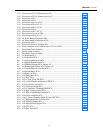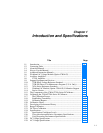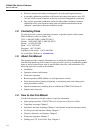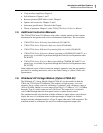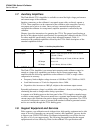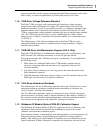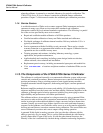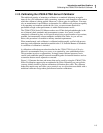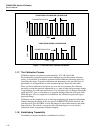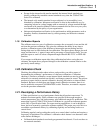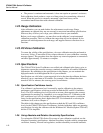
Introduction and Specifications
Support Equipment and Services
1
1-7
ordering instructions for this support equipment and other Fluke instruments, refer to the
Fluke catalog, or contact a representative at a Fluke Sales and Service Center.
1-10. 732B Direct Voltage Reference Standard
The Fluke 732B is a rugged, easily transported solid state direct voltage reference
standard with a highly predictable 10V output. This predictability allows the Fluke
Standards Laboratory, as well as many Fluke customers, to completely eliminate fragile,
saturated standard cells. Laboratories still maintain standard cells using the 732A and
732B as a transportable voltage standard, eliminating the need to transport their standard
cells. The 732B can be short-circuited, even for extended periods of time, without
damage or loss of stability. It maintains full specified stability over a temperature span
of 18 to 28 °C.
The calibrator uses a 10V reference standard such as the Fluke 732B in its semi-
automated calibration procedure to establish external voltage traceability. Chapter 7
describes this procedure.
1-11. 732B-200 Direct Volt Maintenance Program (U.S.A. Only)
The Fluke 732B-200 Direct Volt Maintenance Program provides your laboratory with
NIST-traceable 10V calibration uncertainty as low as 0.6 parts per million.
The program maintains the 732B that you keep in your laboratory. To accomplish this,
the following occurs:
1. Fluke sends you a calibrated Fluke-owned 732B standard, together with all
necessary connecting cables and instructions for comparison with your 10V
reference standard.
2. You take a series of readings over a five-day period, and return the results to the
Fluke Standards Laboratory.
3. The Fluke Standards Laboratory assigns a value to your 10V standard relative to the
NIST legal volt and sends you a report of calibration.
1-12. 742A Series Resistance Standards
The calibrator uses 1Ω and 10 kΩ resistor standards such as the 742A Series in its semi-
automated calibration procedure to establish external traceability of resistance and
current. Chapter 7 describes this procedure.
The 742A Resistance Standards, which are constructed of arrays of Fluke wirewound
precision resistors, are ideally suited as support standards for the calibrator. Stability of
the resistance transfer standards and their temperature coefficients make them ideal for
easy transport to and operation in the calibrator's working environment.
1-13. Wideband AC Module (Option 5700A-03) Calibration Support
The Wideband AC Module (Option 5700A-03) requires two kinds of calibration: gain
and flatness. Gain constants are checked and recalibrated as a part of the normal
calibrator semi-automated calibration process.
Since frequency flatness is determined by such stable parameters as circuit geometry and
dielectric constants, flatness of the Wideband AC module has excellent long-term
stability. This stability gives the Wideband AC Module a two-year calibration cycle for
flatness calibration. Flatness calibration is required only infrequently, and can be done



